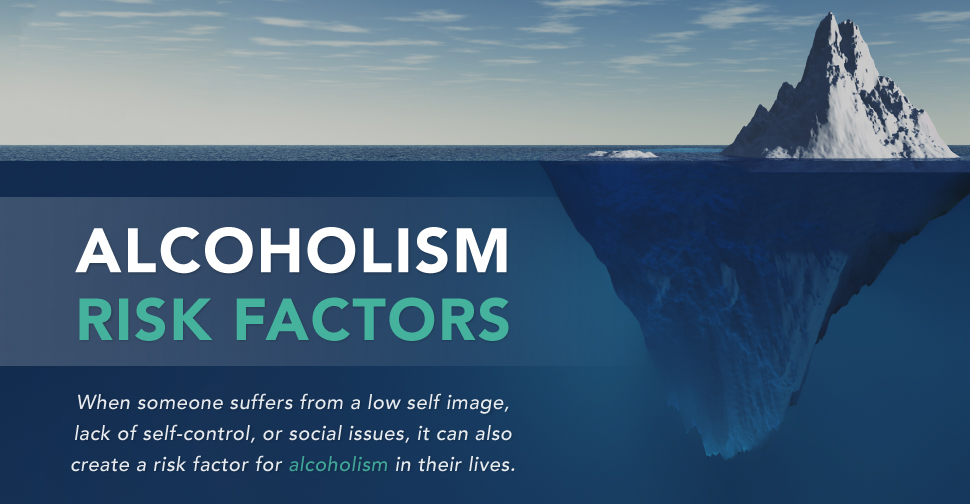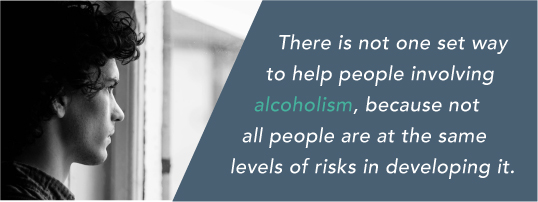
So many people are impacted by alcoholism in our day and age. Alcohol is the drug of choice amongst young people in the United States. Nationwide, in 2014, 16.3 million Americans had an alcohol use disorder. Alcohol abuse and addiction doesn’t stem from one thing, instead a person’s risk is based on cumulative factors that are unique to their life, history, and circumstances. No one lives isolated from the world—because people interact with their communities and societies, everyone has a variety of different risks associated with alcohol.
What Are Risk Factors?
There are a number of different things that can impact a person and put them at risk for having a mental or substance use problem, these are called risk factors. According to the Substance Abuse and Mental Health Services Administration (SAMHSA), “Risk factors are characteristics at the biological, psychological, family, community, or cultural level that precede and are associated with a higher likelihood of negative outcomes.” Every person has different properties that can help aid them or go against them in regards to alcohol abuse and addiction.
When looking at the risks, addressing only one thing won’t get you the results you need—because people experience complex interactions between their environments, history, and relationships, prevention needs to take a multifaceted approach. Everything bounces off each other, creating impacts in different ways. Because of this, it is important not to look at risk factors from a singular perspective—instead, in order to achieve maximum success and prevention, a person should strive to target the way they interact overall.
What Factors Come Into Play In Alcoholism?
In order to better perceive a person’s measure of risk, it is important to understand the forms that risk factors can take. In doing so, you are enabling yourself to be more proactive and preventive within your life. The following are the general domains of risk factors as outlined by the National Institute on Drug Abuse, with examples of specific forms they may take. In addition, we’ve briefly mentioned various ways that these risks may be countered by preventative measures.
Individual— For an individual, there are risk factors specific to them that vary from those around them—even other individuals raised within the same family, community, and/or social settings could have different factors. These include a person’s poor coping response, genetic vulnerability to addiction, their exposure to alcohol within the womb, and any co-occurring mental health disorders such as anxiety, depression, or ADHD.
In addition, the way a person perceives themselves can largely influence their risk—individuals who have a poor self-image and experience a sense of loneliness or isolation paired with a lack of self-control may be more apt to drink. Children and teens have risks unique to their age, including displays of aggression at an early age, peers that use addictive substances, poor peer refusal skills, and a failure to thrive academically. Prevention can occur if a person has a better support system, especially if children have increased connections with positive adult influences or if a person becomes aware of the dangers associated with patterns of alcohol abuse and addiction.
Relationship And Family—When looking at family life, here are some issues that arise when it comes to alcoholism and its risks. These include factors experienced by a young child, adolescent, or teenager and also those that affect adults. If a child is raised by a parent who abuses alcohol, suffers from a mental illness, abuses or neglects the child, or fails to properly supervise their child, it raises the risk of alcohol abuse. Research shows that children who were abused suffer greater instances of substance abuse in adulthood.
In terms of adult risk factors, difficult circumstances like an addiction within the family, divorce, or the loss of a job may push a person towards alcohol abuse, as does a lack of general family involvement. A parent’s influence in such cases can aid to protect the further spread of the abuse of alcohol. Within a relationship, better communication and an increased focus on spending meaningful time with each other may also help.
Peer—Peer pressure is especially impactful in young people, however, adults are not immune to the effects. If a child’s group of friends portrays expectations of alcohol use or acts as if it is fun, a child may be more apt to experiment. College-aged students experience heightened risks— dangers that can be fatal. There are an estimated 1,825 college students between the ages of 18-24 that end up in a fatal alcohol-induced accidental injury or car crash. Adults may face these influences from spouses, other family members, coworkers, or even clients. Engaging in activities that do not revolve around or include drinking can help protect you, as will surrounding yourself with peers that do not condone alcohol abuse.

School—When a student of any age cannot connect to their education or properly develop a sense of ambition or pride, they may be more apt to abuse alcohol. Sometimes this may be due to the fact that they do not have adequate expectations to strive towards. To counter this, developing clear goals, maintaining regular attendance, becoming involved in school programs, and being exposed to positive academic encouragement, can all help a person overcome school-related alcohol abuse risks.
Community/Social—If a neighborhood experiences violence, racism, a lack of opportunity, high unemployment levels, poverty, a sense of disconnect between residents, and a lack of social outreach, among other things, it may increase the risks of involvement with alcohol for the residents. Risk may also increase in the presence of greater availability to alcohol, in an environment where different laws pertaining to alcohol use appear vague or are not enforced, or if alcohol abuse appears “normal” and accepted among a person’s peers and the media. A protective stance against this would be laws against hate crimes, limitation of the availability of alcohol, faith-based involvement and after-school hobbies for residents, and programs that educate community members about alcohol abuse risk factors.
Risks Create More Risks
When a person is exposed to one risk factor, generally they are often exposed to even more—a butterfly effect. If left unchecked, instead of gaining protection against these, often times the danger snowballs in the opposite direction. When young people are exposed to many risk factors, it creates a higher risk of a physical or mental health condition later on down the road, including an alcohol use disorder. Not every person that experiences a high measure of risk will develop an alcohol use disorder. When there are higher protective factors, these young people have a much lower chance of developing such problems. The same holds true for adults.
Just as certain risks can accumulate into more risks, so can positive factors build into more positive changes. Over the course of a person’s lifetime, risks or protection can happen, either alone or together. When parents are effective and involved in their child’s life, it decreases the impact of certain risks, such as divorce, poverty, or the effects of a parent’s mental illness, thus protecting the child from further risk as they grow into an adult. When we have a good grasp on how these risk and protective factors influence us, we will be better able to build a life that is strong in the face of negative influences.
Preventative Factors
There is not one set way to help people who have a greater risk of developing an alcohol addiction, because not all people experience the same levels of risks, nor do they experience the same situations or environments. To help aid people with prevention, all facts must be considered. We have to ask, “What is the level of risk?” In order to address these issues, a good way to combat risks is to speak to larger societal groups, such as schools, an entire community, or within the workplace about preventative measures.

A broader intervention may look at psychological, biological, or social risks in an environment affecting a particular demographic of people, whereas a more targeted intervention may work towards addressing risk factors that are of concern to a certain individual. Directing prevention towards specific areas or people who are at a higher risk, will help towards preventing alcohol abuse and addiction.
 Avoid The Risks
Avoid The Risks
If you or a loved one feels that your risk factors are high, or if you are in need of help, please reach out and contact us today at DrugRehab.org. Reduce your risks and get the help you need to have a healthier life.
Sources
Substance Abuse and Mental Health Services Administration—Risk and Protective Factors
Mass.gov—Risk & Protective Factors
National Institute on Alcohol Abuse and Alcoholism — Alcohol Facts and Statistics
